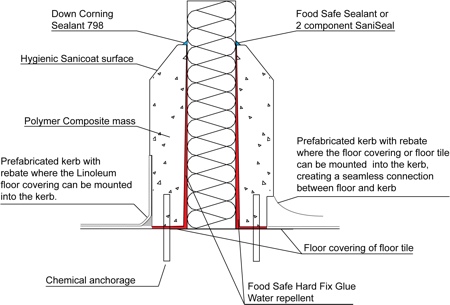For the past 25 years, sandwich panel constructions have been the most popular way to erect food safe rooms in Europe, because they offer fast installation, are easy to clean and provide good insulation value. Nevertheless, sandwich panels are very weak and quickly damaged.
In many of these buildings, the kerbs and plinths around the base of the walls used in this building scheme are usually made on site in the manufacturing plant during construction; they are composed of concrete and covered by the floor finishing. This system has some important disadvantages with regard to food safety, impact resistance and maintenance.
Concrete covered by any kind of flooring material is never a monolithic system and after a period of time, the bonding between the concrete and the floor material will break down as the concrete deteriorates due to exposure to humidity and acids in the air and other physical impacts to the surface. Physical impacts from trolleys, forklifts, hand pallets and cleaning machines cause cracks to appear in the floor covering (see Figures 2 and 4).
The result is that dirt and cleaning water start to leak through those cracks, building up behind the floor covering and being absorbed by the concrete. This trapped dirty water will eventually begin to evaporate, and the humidity thus created will cause a rise in pressure behind the floor covering.
The pressure eventually breaks the bonding between the concrete and the floor finishing, exposing the concrete and creating food safety issues as dirt builds up in the resulting crevices and provides a harbour for harmful bacteria.
Another problem that frequently arises when using concrete kerbs is that the seal between the panel and concrete kerb can break. The difficulty is that there is no bonding with water-resistant glue or sealant between the concrete and sandwich panel. As a result, dirty water will begin to accumulate behind the concrete kerbs creating a niche where micro-organisms can survive and grow and becoming a cross-contamination risk in the food production environment.
For these reasons, kerbs used in logistic and low-care environments where hygiene is a priority should be constructed with materials that are resistant to chemicals, impact and water.
Polymer composites
Polymer composite kerbs and plinths provide a solution to the hygiene challenges posed by kerbs composed of concrete. Prefabricated polymer composite kerb systems are made by mixing polyester resins and quartz granulates with the surface and then finished with a bacteriostatic and shock-resistant polyester gel coat surface. In the production of these kerbs, a monolithic system is created by moulding together the polyester quartz mass with the polyester gel coat covering. Both materials have the same chemical structure (polyester), which creates a strong kerb that is easy to clean, water- and chemical-resistant and repairable.

Figure 3: Hygienic kerbs and plinths for cleanroom environments
In addition to being fabricated from hygiene-promoting materials, polymer composite kerbs can be installed to improve hygiene in cleanrooms or critical manufacturing environments.
These kerbs are bonded to the sandwich panel with a flexible; water-resistant polymer glue. The joints can be finished with a food-safe flexible sealant that is easy to dismantle for cleaning, or with a two-component polyurethane finish (see Figures 1 and 3). Even if the joints become damaged, the polymer glue creates a secondary water barrier so that water cannot infiltrate or become trapped behind the kerb. If the gel coat is damaged by heavy impacts over a period of time, the high water-resistance of the polymer composite mass will prevent water absorption.

Figure 4: A crack that can harbour bacteria
Damage or scratches to these types of kerbs can be easily repaired with a cleaner or a two-component repair kit. Finally, polymer composite kerbs can be delivered with a food-safe curving for renovations or with a rebate in the front to create a seamless connection with the floor curving.

Figure 5: Sectional drawing showing hygienic advantages of polymer composite kerbs




